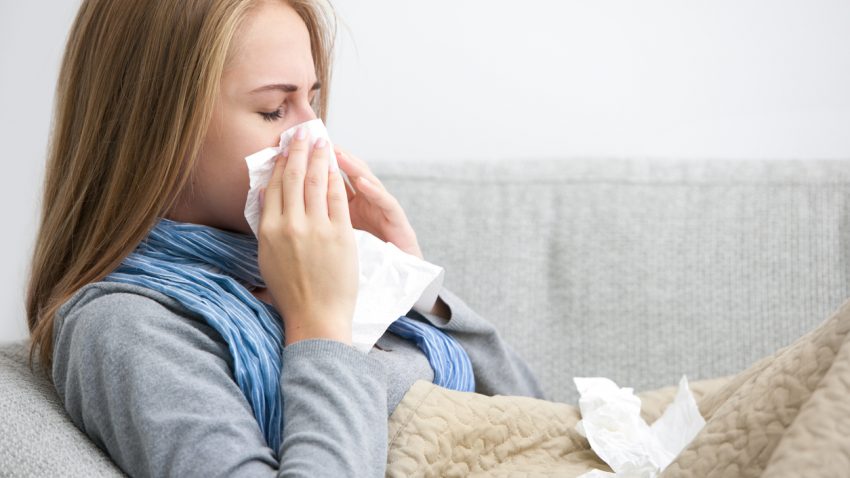

Flu Season: How to Prevent the Spread of Infections
A Simple Guide to What You Need to Know About Avoiding Influenza
According to the CDC, February is peak flu month.[1] However, just because February’s over doesn’t mean that you’re safe from influenza. Although seasonal flu circulates in fall and winter, this nasty infection still runs strong all year round and can be debilitating for anyone who contracts it.
In this article, we cover the various ways you can protect yourself, colleagues, friends and family from the flu and what you can do if you’re unfortunate enough to be infected.
What Is the Flu?
Influenza, more commonly known as the flu, is a contagious respiratory viral illness. It infects the nose, throat, and lungs and usually causes mild to severe symptoms and is sometimes confused with a cold. However, although colds tend to be milder, the flu can be deadly. It has been estimated that the flu is responsible for between 3,000-49,000 deaths each year[2], making it important for people to be aware of the signs of flu so they can seek appropriate treatment.
People suffering from flu may feel some or all of these symptoms:
- Fever (although it is important to note that if you do not have a fever, you may still have flu)
- Chills
- Coughing
- Sore throat
- Aches and pains
- Headache
- Extreme tiredness
- Vomiting and/or diarrhea (this is more likely among children than adults)
Is the Flu Different to H1N1 Swine Flu?
There are numerous types of flu virus, which mutate and change all the time to produce new strains of the flu. H1N1 swine flu is a type of influenza virus that was identified in April 2009. People across the globe were infected with the virus and an H1N1 swine flu pandemic was declared in June 2009. Although cases have since declined, the H1N1 swine flu virus is still in circulation, although a vaccine is available for the infection.
How Do You Catch the Flu?
It is believed that the flu virus is spread by droplet contamination when an infected person coughs, sneezes or speaks. This spreads contaminated saliva droplets to the surrounding area, potentially landing in the mouth or nose of someone nearby, infecting them with the virus. It is also possible to contract the flu virus by touching something that has the virus on it and then touching your mouth, nose or eyes.
Once you have the flu virus, flu symptoms will start between 1-4 days later, with most people feeling ill 2 days after infection. However, you are potentially contagious before you are aware of any symptoms. The majority of healthy adults may be capable of spreading the infection 1 day before any symptoms manifest and are then infectious for up to 7 days after symptoms start. However, this period of infectivity may last for longer for young children, and adults with a weakened immune system.[3]
What Are the Potential Complications of the Flu?
In the majority of cases the flu is relatively benign, but in some instances it can cause some serious complications, including bacterial pneumonia, ear or sinus infections and dehydration. In addition, it may also cause existing chronic medical conditions to worsen, such as congestive heart failure, asthma and diabetes.
Although such severe reactions can happen to anyone, certain demographics are at an increased risk of developing serious complications if they catch the flu. These include adults aged 65 or older, as well as those with existing specific chronic conditions, e.g. asthma, diabetes or heart disease, those with weakened immune systems, pregnant women, and young children.

Consulting your doctor about your flu symptoms
How Is the Flu Diagnosed?
When you first start feeling unwell, the flu will be suspected if you display the symptoms typically associated with the infection. The flu virus is responsible for most respiratory illnesses during fall and winter, so it is not unreasonable to assume that you have the flu based on your symptoms alone. However, there are other viruses that can cause similar conditions, so if your doctor needs confirmation that you have the flu, there are laboratory tests available.
The most frequently used flu tests are the ‘rapid influenza diagnostic tests’ that can give a result within 30 minutes. However, these tests are not always accurate, so it is possible to have a negative result and still have the flu. You may still be diagnosed with the flu by your physician even if your test comes back negative. If you require definite results, a health care professional will need to take a swab from the inside of your nose or the back of your throat and send it for more detailed testing in a specialized laboratory.
Your healthcare professional will decide whether a flu test is necessary. In most cases, since the treatment plan will not change according to a test result, physicians will rely on their clinical expertise and experience to diagnose the flu without the need for a test. However, if there is a current outbreak of a specific respiratory illness, testing can help confirm whether the outbreak is down to the flu virus. It is also helpful to know if someone has the flu if they are pregnant or have a weak immune system, as this may affect the treatment they receive.
How Do I Combat the Spread of the Flu Virus?
There are some simple steps that everyone can take that will help limit the spread of the flu virus. Always use a tissue to cover your nose and mouth when you cough or sneeze, and dispose of it after single use. Wash your hands frequently using soap and water. If you do not have access to soap and water, use an alcohol-based hand rub to sanitize your hands. Try not to touch your eyes, nose or mouth with dirty hands – this is how germs spread. As well as your hands, clean surfaces and objects such as door handles, phones, and children’s toys, disinfecting them if there is any chance that they have been contaminated with germs.
Limit close contact with people who are unwell and if you are sick, try to avoid other people as much as possible to reduce the risk of infection. The CDC recommends that anyone displaying flu symptoms should stay home for a minimum of 24 hours after their fever has gone, apart from seeking medical treatment or other necessities. It is worth remembering that a fever will usually go away by itself within 24 hours without the need for fever-reducing medication.[4]
If your job involves coming into contact with people suffering from the flu, for example if you work in a healthcare facility, you may want to consider using personal protective equipment such as a facemask. Visitors may also be advised to use protective equipment, both to protect themselves from infection and also to stop their potentially infecting others. Although this may not extend to all visitors, if a patient is coughing when they arrive at a clinic, it may be a good idea to request that they wear a facemask.
In some industries, such as healthcare workers who are in direct contact with patients or deal with infected bodily fluids, workplace vaccination is mandatory and the flu vaccine will be paid for by the employer. Although workplace vaccination may not be mandatory in other industries, many employers choose to fund workplace vaccination programs to ensure a high uptake of the vaccine, minimizing the risk of time off due to flu infection. Alternatively, some employers may arrange transportation to a clinic for the flu shot or arrange for a mobile clinic to come to the workplace so that employees can be easily vaccinated.
Prevention is always preferable to treatment and maintaining a healthy lifestyle goes a long way to help your body fight off a potential flu infection. Make sure that you exercise regularly, get a good night’s sleep and practice stress management. Eat a healthy diet with plenty of fresh fruit and vegetables and drink lots of fluids, preferably water.
Keeping your body in optimum condition is a good way to stave off the flu virus.

Getting the flu vaccine
Should I Get a Flu Shot?
The CDC recommends an annual flu vaccine for everyone over the age of 6 months (with a few exceptions) to reduce your risk of catching the flu.[5] However, the vaccine is not 100% effective and cannot guarantee that you will not suffer flu-like symptoms because it does not protect against all the different strains of the flu virus. Instead, scientists predict which strains are likely to be the most common in the coming flu season and incorporate those into the latest vaccine. In addition, there are other, non-flu illnesses that can cause similar symptoms that the vaccine does not protect against.
The optimum time to get your flu shot is in the fall, between September and the end of October, to make sure that you are fully protected before flu season begins. If you struggle to get to your doctor for a flu shot, there are convenient alternatives, with the vaccine offered in many local grocery stores and pharmacies without the need for an appointment.
The flu vaccine is available as an injection and a nasal spray. However, recommendations vary each year as to which vaccines should be given and different flu shots are approved for different age groups.
Flu shots have been approved for pregnant women and those with chronic health conditions, although there are some people who should not receive the vaccine. These include babies under the age of 6 months and those who have serious, life-threatening allergies to any of the ingredients contained in the vaccine, such as gelatin or antibiotics. In addition, some people with a history of GBS (Guillain-Barré Syndrome) are advised against having the vaccine. If you are feeling unwell, discuss your symptoms with your physician before going ahead with the shot.
In the past, if you have an egg allergy, monitoring was required for 30 minutes after vaccination to avoid any side effects. Monitoring is no longer necessary, although it is still advised that those who have severe egg allergies should receive the flu shot in a medical facility under the supervision of a healthcare professional conversant with the recognition and management of severe allergic reactions.
Treating the Flu
If you are unfortunate enough to get sick, staying away from others as much as possible reduces the chance of your passing on the virus, limiting the spread of the infection. Resting will also help you feel better faster. Prescription antiviral medication taken shortly after symptoms start can help treat the infection, but there are many other simple ways in which you can support your body through the recovery process.
Make sure you drink plenty of fluids and stay hydrated, especially if you are vomiting. Water, fruit juice, and herbal tea are all good things to drink, but avoid caffeinated beverages – they’re a diuretic and will make you feel worse. Many people swear by a nice bowl of chicken soup and a study published in Chest[6] supports its soothing benefits.
If you are suffering from headaches or sinus pain, a warm compress on your forehead or nose will help relieve the tension. Steam therapy can also work wonders. If you don’t feel up to having a shower, simply sitting in the same room while you run steamy, hot water will help clear your airways. Alternatively, fill a bowl with boiling water and place a towel over your head while you lean over and breathe in the steam for up to 30 seconds. You may find it helps to add a couple of drops of peppermint or eucalyptus essential oil, but be careful you don’t add too much – essential oils have a powerful effect.
Finally, nothing beats having someone look after you. If a friend or family member offers to come round and help out, let them, even if it’s just to check in on you for five minutes. Knowing that there’s someone there support you really does make a big difference.
Did you or anyone you know get the flu this year? How did you treat it? Did you have your flu shot? Tell us your flu stories in the comments below.
Sources:
[1] https://www.cdc.gov/flu/about/season/flu-season.htm
[2] http://www.sfcdcp.org/flufacts.html
[3] https://www.cdc.gov/flu/keyfacts.htm
[4] https://www.cdc.gov/flu/pdf/freeresources/updated/everyday_preventive.pdf
[5] https://www.cdc.gov/flu/protect/whoshouldvax.htm#flu-shot
[6] http://www.webmd.com/cold-and-flu/features/treating-flu-at-home#1

